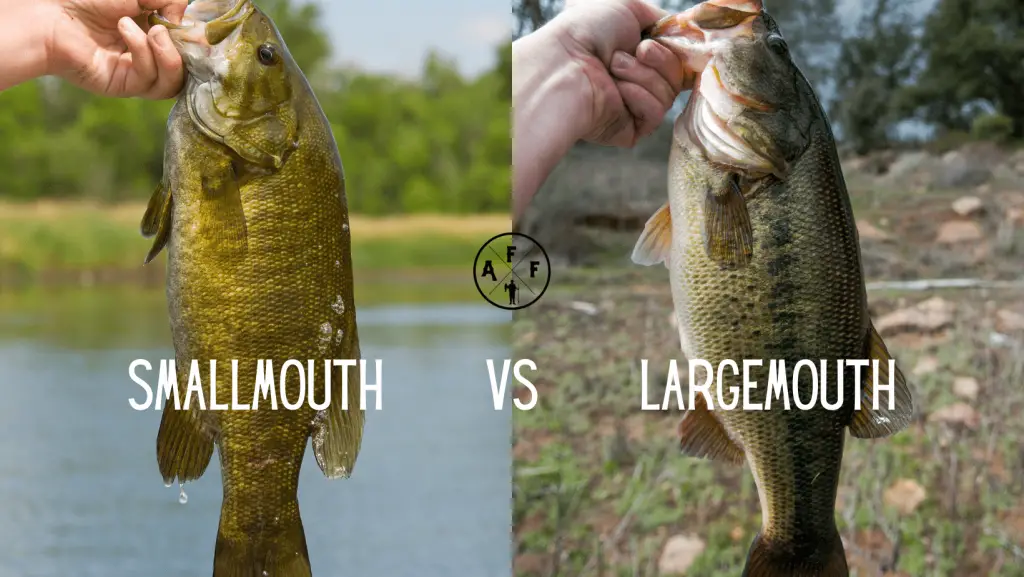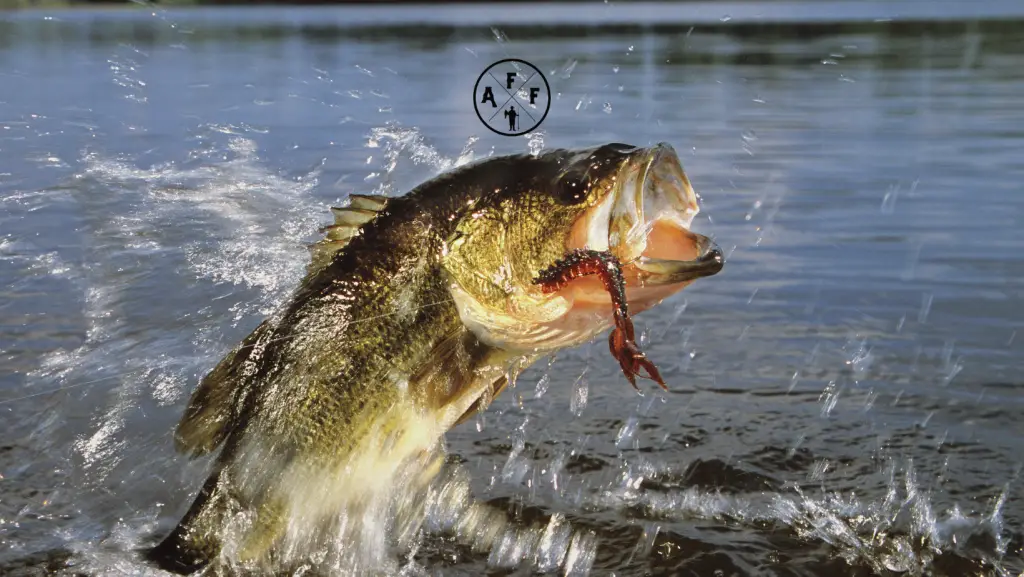
Hey there! Thanks for reading this post about Smallmouth vs. Largemouth Bass.
Most people think that all Bass are the same, but there is a big difference between these two types of Bass. In this article, I’ll outline the key differences in their appearance, habitats, and feeding times, plus the tactics and lures I have used to catch Bass for over 20 years.
You will be able to catch more Bass by knowing their habits and what lures to use for both large and Smallmouth Bass while also understanding the critical difference between these two species.
How to Tell the Difference Between Largemouth and Smallmouth Bass
There are key differences between these two bass species, including size & weight, mouth size, fins, and overall appearance. Using these identifiers is the best way to distinguish a Smallmouth from a Largemouth.
Size & Weight
When it comes to size and weight, Smallmouth Bass usually range between 14 and 20 inches and up to 8 pounds, while Largemouth Bass are typically larger. Largemouth Bass can reach 26 inches and weigh over 20 pounds!
Mouth Size
This one seems obvious. The Smallmouth Bass has a noticeably smaller mouth than the Largemouth Bass.
One way to verify that one’s mouth is bigger or smaller than the other is to notice where the mouth reaches in relationship to the eye.
Smallmouth Bass have small mouths with lips that barely reach the eyes, while Largemouth have much wider mouths that extend noticeably past their eyes.
Fins
The Smallmouth and Largemouth also differ in their fins, particularly the dorsal fins. Largemouth bass has dorsal fins broken into two sections, while the Smallmouth has one continuous dorsal fin. This difference in dorsal fins is the most popular way of distinguishing these two species.
Overall Appearance
The Smallmouth Bass has a thin and elongated body compared to the stockier, wide-bodied shape of the Largemouth Bass.
Additionally, Smallmouths have the nickname Brown Bass due to having a darker color, while Largemouths have lighter sides resembling an olive green color, hence the nickname Green Bass and Black Bass.
Largemouth and Smallmouth Bass Habitats
Regarding habitat, these two bass species prefer freshwater lakes, rivers, and ponds. However, the critical difference in habitat preference includes water temperature, clarity, amount of cover/structure, and currents.
While these two fish can occasionally be found in the same bodies of water, they will most likely be in different parts of the lake or river.
Largemouth Bass Habitat
Largemouth Bass tend to prefer warmer water temperatures in comparison to Smallmouth Bass. Hence, you will find Largemouth Bass more in southern lakes, rivers, and ponds.
You will notice in many country songs written in the South that the artist refers to Largemouth and not Smallmouth when singing about fishing.
Aside from temperature, Largemouth Bass also prefer sandy bottoms where a lot of natural vegetation is present. Vegetation like grasses, stumps, brush piles, and branches provide thick cover for this fish species to feed on and hide.
Another critical difference in habitat is the amount of current that is present. Largemouth Bass often avoid strong currents and wait for their prey in calmer waters amongst thick cover.
Smallmouth Bass Habitat
Smallmouth Bass prefer colder water temperatures, hence why you more regularly find Smallmouth Bass in the great lakes region.
These two species both love the cover, but in different ways.
Smallmouth bass doesn’t enter the cover or thick vegetation but rather swim around looking for small bait fish from the outside while waiting to strike.
While Largemouth Bass avoid the heavy current, Smallmouth Bass thrive in it. Smallmouth Bass anglers know that casting directly into a fast-moving current for this species gives you a great chance of landing one.
Smallmouth vs. Largemouth Bass Feeding Times
Any angler knows that fishing during feeding times gives you the ultimate advantage. But figuring out these feeding times is exceptionally tricky as so many variables play a part. These variables include location, time of year, weather, water depth, barometric pressure, precipitation, etc.
I’ll share with you some commonalities I have noticed over the years.
When to Fish for Largemouth Bass
Targeting Largemouth Bass in the summer has always yielded the best results for me. More specifically, cloudy days when it is drizzling while remaining calm without too much wind is a bass angler’s dream.
Largemouth Bass angling in high winds is not ideal. Windy conditions tend to make this species scatter and leave their hiding spots, making it more difficult to find.
When to Fish for Smallmouth Bass
On the other hand, Smallmouth Bass stick to cooler water temperatures, meaning they congregate deeper during the summer months and scatter, making them harder to catch.
While spawning in the Spring, Smallmouth Bass stick to the shallow waters and tend to stay in the general areas, making the springtime the best season to fish for Smallmouth Bass.
While cloudy and rainy days are the time to target Largemouth Bass, the opposite is true for Smallmouth Bass fishing. Brown Bass prefer to feed consistently during clear days and in calm water.
One common feeding trait is that these two fish both prefer minimal wind. Once the wind kicks up, both Small and Largemouth Bass start scattering, making finding them more challenging.
Smallmouth vs. Largemouth Bass Tactics & Lures
Whether you are fishing for Smallmouth or Largemouth Bass, anglers will swear by specific tactics. The thing is, these different anglers all use other tactics.
That said, there is no one way to fish for Bass. Typical lures in the bass fishing industry include finesse worms, football jigs, jerk baits, crankbaits, topwater plugs, soft plastics, and spinnerbaits.
Yes, I will realize I just named almost every lure out there. That is precisely my point.
Largemouth Bass Fishing Tactics & Lures
Although it’s hard to agree on lure selection, one thing most Largemouth Bass anglers can agree on is this – flipping and pitching is the best way to catch Largemouth Bass.
Large plugs, crankbaits, or 1/2 oz jigs all work well with this technique, and as long as you are in the right area (somewhere with cover) and use my other Largemouth Bass fishing tips, chances are you will land a lunker.
Smallmouth Bass Fishing Tactics & Lures
For Smallmouth Bass, anglers prefer jerk baits and crawdad imitations. Smallmouths love to hit baits that reflect a fleeing prey fish.
Mid-size crankbaits, spinnerbaits, and tube jigs are also great Smallmouth lures. Smallmouth Bass also love topwater lures, so if you are in the right area, grab a few poppers and throw them out.
Common Questions Related to Bass Fishing

When it comes to bass angling, there are many questions I regularly get that I will provide answers to below.
Are Smallmouth Bass good eating?
Yes, Smallmouth bass are great for eating! Smallmouth Bass hold up well on the grill or be fried and have a light, flaky texture.
Are Largemouth Bass good eating?
Yes, Largemouth Bass are also excellent for eating! Although both Large and Smallmouth Bass are not my favorite freshwater species, they still make excellent table fare.
Check out this article for a full rundown of thoughts on whether Largemouth is good eating.
Are Smallmouth bass easier to catch than Largemouth?
This question is tricky and depends on the angler’s skill level, fishing conditions, location, and technique.
Generally speaking, Smallmouth Bass tend to be more aggressive feeders than Largemouth, so that they can be caught more easily in certain situations. Smallmouths also tend to school up, making them easier to target in large numbers.
There is no definitive answer – it depends on your skills and conditions! Ultimately, Smallmouth and Largemouth Bass can be challenging and rewarding fish.
Are Smallmouth and Largemouth Bass the same species?
No, Smallmouth and Largemouth Bass are two different species. Smallmouth Bass (Micropterus dolomieu) is a sunfish family member found in rivers, streams, and lakes throughout North America.
Largemouth Bass (Micropterus salmoides) is also part of the sunfish family and is native to southeastern North America. They are typically found in warmer bodies of water such as lakes, reservoirs, ponds, and slow-moving rivers.
While they belong to the same family, Smallmouth and Largemouth Bass are different species.
Which is more aggressive, Smallmouth or Largemouth Bass?
This is a difficult question because it depends on the individual fish and their location. Smallmouth are generally considered more aggressive feeders, while Largemouth Bass can be finicky in certain situations.
That said, some Smallmouth Bass can be very picky, and some Largemouth may go after bait with reckless abandon. It depends on the individual fish and the conditions they are in.
Does it hurt Bass to hold them by the lip?
No, it should not hurt a bass to be held by the lip as long as you are gentle. Small and Largemouth have thick lips that won’t easily tear or rip, although they may become irritated if handled too roughly.
If you need to grab a Smallmouth or Largemouth Bass by the lip, follow best practices for handling fish.
Can Largemouth bass live in saltwater?
No, Largemouth bass cannot survive in saltwater environments. They need freshwater to survive, while Smallmouth can adapt to brackish waters.
Do smallmouth fight harder than Largemouth?
Yes, Smallmouth Bass are known to fight much harder than Largemouth. Smallmouth Bass have a reputation for making long runs and putting up an intense fight.
Largemouth can also put up a good fight, but Smallmouth Bass tend to be more aggressive and will often require heavier tackle than their larger counterparts.
Why do restaurants not serve Bass?
It is almost impossible for restaurants and the FDA to verify that Bass originate from clean sources of water that are not contaminated.
Bass can live in just about any freshwater environment, so it is difficult to tell where a particular fish came from and whether it is safe to eat. This is why restaurants do not serve Smallmouth or Largemouth Bass.
Largemouth vs. Smallmouth Bass Conclusion

Ultimately, Small and Largemouth Bass are two different species that have unique characteristics and behaviors.
Catching both species of Bass will put a smile on any angler’s face, and they are so famous for good reasons.
Since I live in the South, I am much more familiar with Largemouth Bass fishing, and I am biased when comparing the two. As far as freshwater fishing is concerned, Largemouth fishing is right beside Walleye as my favorite freshwater species to target.
However, when planning fishing trips on the Great Lakes, Smallmouth Bass are on my mind, and I get so excited for the incredible Smallmouth fishing I know is ahead.
No matter what species you choose to target, Largemouth and Smallmouth Bass are two of the most popular freshwater game fish in North America and offer anglers a great way to spend time on the water. So go out there, and catch some Smallmouth or Largemouth, depending on where you live!
Tight lines!
For more guides on bass fishing, check out the pages below:










